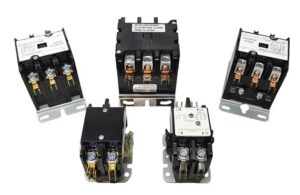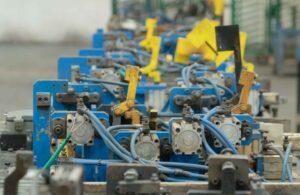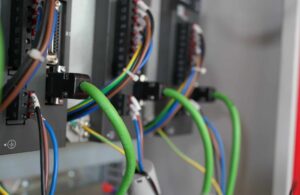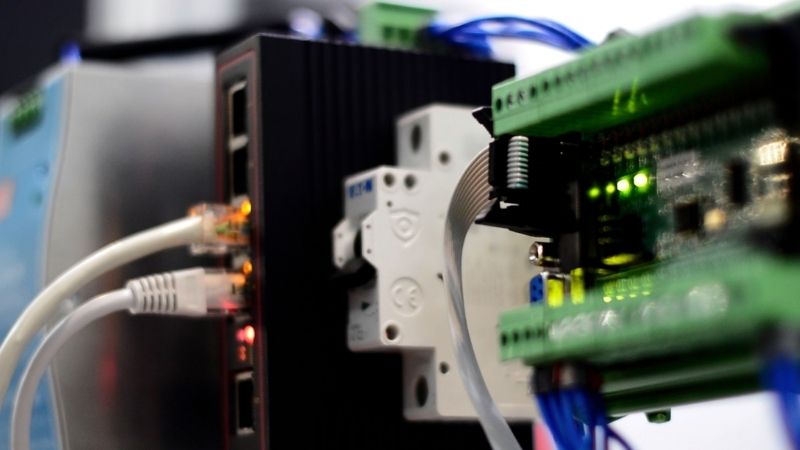Comprendre la différence entre l'amortissement et l'approvisionnement dans les systèmes PLC
Dans ce blog, nous allons décomposer le concept d'enfoncement et d'approvisionnement étape par étape, en expliquant sa signification, ses applications et des exemples pratiques pour vous aider à maîtriser cet aspect essentiel de Automates programmables.
Table des matières
Que sont l'amortissement et le sourcing dans les PLC ?
Les termes « sinking » et « sourcing » décrivent la direction du flux de courant entre les appareils d'un système PLC. Ces termes s'appliquent spécifiquement aux circuits CC et ne s'appliquent pas aux circuits CA. Dans le cas d'un sinking, le courant circule dans un appareil à partir de la charge, tandis que dans le cas d'un sourcing, le courant circule hors d'un appareil vers la charge. Il est essentiel de comprendre cette différence lors de la sélection des modules d'entrée et de sortie pour votre système PLC.
Entrées PLC numériques : les bases
Les modules d'entrée PLC s'interfacent avec des appareils qui envoient des signaux binaires (ON/OFF). Ces modules traitent les signaux provenant de commutateurs, de capteurs ou de boutons pour déterminer l'état des appareils de terrain connectés. Les entrées numériques sont classées comme suit :
- Sources d'approvisionnement : Ces modules fournissent une tension positive au circuit externe.
- Entrées d'enfoncement : Ces modules fournissent une connexion à la terre pour compléter le circuit.
Exemples d'appareils de terrain pour les entrées PLC
- Boutons poussoirs : Les boutons Marche/Arrêt génèrent des signaux selon qu'ils sont normalement ouverts (NO) ou normalement fermés (NF).
- Commutateurs de sélection : Utilisé pour le contrôle multi-positions, souvent observé dans les applications de contrôle de la vitesse du ventilateur ou du moteur.
- Capteurs de proximité : Détecte la présence d'objets sans contact physique, en émettant des signaux binaires pour le traitement de l'automate.
Sorties PLC numériques : dispositifs de contrôle
Les sorties PLC contrôlent des périphériques tels que moteurs, des radiateurs ou des solénoïdes en envoyant des signaux binaires basés sur la logique du programme. Les sorties peuvent également être classées comme étant à absorption ou à source, en fonction de leur câblage et de leur fonction :
- Résultats de l'approvisionnement : Fournir du courant aux appareils externes.
- Sorties de naufrage : Servir de connexion à la terre pour les circuits externes.
Types de sorties PLC numériques
- Sorties relais : Universel pour les applications AC et DC, offrant une flexibilité avec des vitesses de commutation modérées.
- Sorties transistorisées : Idéal pour la commutation CC rapide, couramment utilisé dans l'éclairage ou les circuits basse consommation.
- Sorties TRIAC : Spécialement conçu pour les charges CA, telles que les éclairages ou les démarreurs de moteurs.
Exemples pratiques de naufrage et d'approvisionnement
Exemple 1 : module d'entrée d'approvisionnement avec un bouton d'arrêt
Dans cette configuration, le module d'entrée fournit une tension positive, tandis que le bouton d'arrêt agit comme un dispositif de dissipation, complétant le circuit lorsqu'il est enfoncé.
Exemple 2 : module de sortie à courant descendant avec une charge de relais
Ici, le module de sortie fournit une connexion à la terre et la charge du relais fournit du courant à partir de l'alimentation, garantissant ainsi le bon fonctionnement du circuit.
Sélection du module d'entrée ou de sortie approprié
Le choix entre les modules d'absorption et d'approvisionnement dépend des exigences de votre système :
- Vérifiez la polarité des appareils de votre circuit.
- Tenez compte de la compatibilité avec les appareils de terrain.
- Évaluez les besoins en courant et en tension de votre application.
Conseils de câblage pour les modules d'alimentation et de source
- Consultez les schémas du fabricant pour identifier le type de module.
- Assurez un alignement de polarité correct pour éviter les erreurs de circuit.
- Testez le système après le câblage pour vérifier la fonctionnalité souhaitée.
Alimentez vos projets avec des PLC Omron, Mitsubishi, Schneider flambant neufs et originaux – en stock, prêts maintenant !
Conclusion
Les concepts de courant absorbé et de courant de source dans les systèmes PLC sont essentiels pour gérer le flux de courant dans les modules d'entrée et de sortie numériques. En comprenant les différences et en sachant comment les appliquer, vous pouvez concevoir des systèmes de contrôle plus efficaces et plus fiables. Qu'il s'agisse de boutons, de capteurs ou de relais, ces connaissances garantissent le bon fonctionnement de votre configuration PLC.
Vous recherchez des automates neufs et originaux pour vos projets ? Chez Kwoco, nous proposons les derniers automates des plus grandes marques telles que Omron, Mitsubishi, et SchneiderAchetez en toute confiance : expédition rapide, qualité garantie ! Achetez maintenant
Contactez-nous
Remplissez simplement votre nom, votre adresse e-mail et une brève description de votre demande dans ce formulaire. Nous vous contacterons dans les 24 heures.
Catégorie de produit
Produits en vente à chaud
Ces sujets pourraient également vous intéresser

Qu'est-ce qu'un contacteur magnétique et à quoi sert-il ?
Les contacteurs magnétiques sont des composants essentiels des systèmes d'automatisation industrielle et de contrôle électrique. Ils jouent un rôle crucial dans la gestion des charges à haute puissance et dans la garantie du fonctionnement sûr des machines. Cet article offre un aperçu complet des contacteurs magnétiques, en expliquant leur fonctionnalité, leurs types et leurs applications. Il explique également comment ces dispositifs contribuent à l'efficacité et à la fiabilité des processus industriels.

Interrupteurs de fin de course expliqués : types, utilisations et principes de fonctionnement
Les interrupteurs de fin de course sont un composant essentiel de nombreux appareils et machines, jouant un rôle clé dans la détection de la présence ou de l'absence d'un objet. Qu'il s'agisse d'une porte de réfrigérateur ou d'une machine industrielle, les interrupteurs de fin de course sont des héros de l'ombre, remplissant des fonctions qui garantissent un fonctionnement fluide et sûr.

Quelle est la différence entre PLC et CNC ?
Avez-vous déjà été intrigué par les termes PLC et CNC dans le monde de l'automatisation industrielle ? Vous n'êtes pas le seul. De nombreux professionnels ont du mal à distinguer ces deux systèmes cruciaux, en particulier lorsqu'ils doivent prendre des décisions d'achat.
Certains automates programmables de petite taille, notamment les unités compactes avec points d'E/S intégrés, sont équipés d'alimentations intégrées. Ces dernières acceptent directement l'entrée CA et la convertissent en tension CC nécessaire en interne.
- Avantages : Installation facile et besoin réduit de composants externes.
- Limites: Courant de sortie limité, ce qui les rend adaptés uniquement aux petits systèmes d'automatisation.






